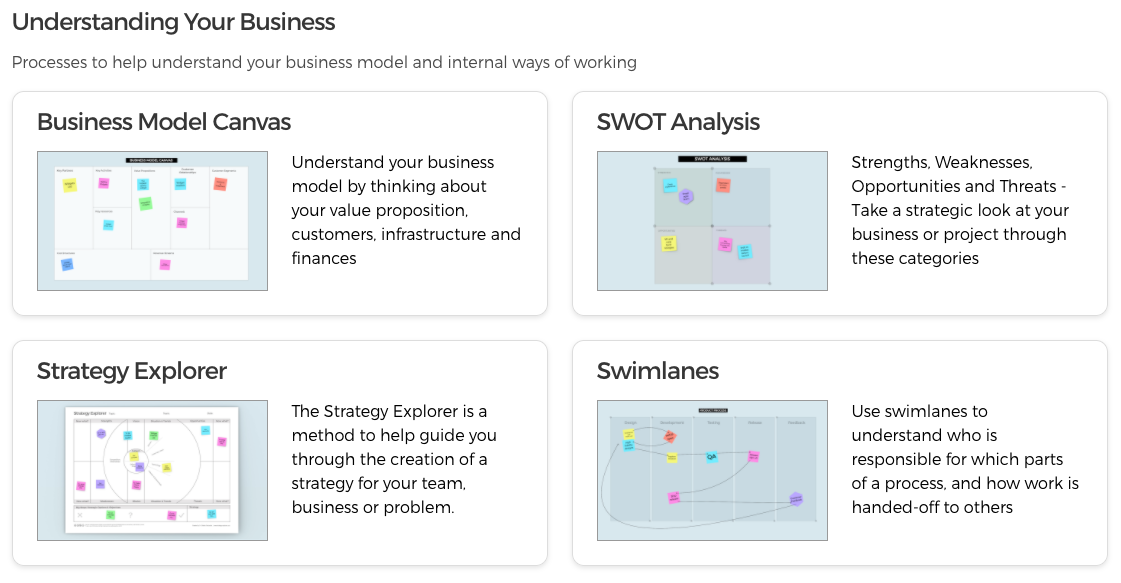Understanding Your Business With Ideaflip
We work in our businesses every day. Carefully ticking off each task, working with colleagues, meeting the demands of our clients and customers - all important action steps. But when was the last time you took the time to step back, plan ahead further, or think a little more strategically?
Our Understanding Your Business Ideaflip templates set out a variety of processes. Each aims to help you and your team members to understand your business a little better - from detailed internal methods, to taking a birds-eye view.

So book a 30 minute slot in your calendar, grab a cuppa, and choose one of the templates below. It’s time to work on your business, not just in it.
SWOT Analysis
Strengths, Weaknesses, Opportunities, and Threats create the acronym SWOT. Our specific SWOT Analysis template is a minimalist board, clearly labelled and ready for your ideas. You’ll want to engage with this type of process before a project really kicks off.
As the board gets filled out with your sticky notes, comments, arrows, and reactions, a picture builds of how feasible this idea is - and the next steps you might want to pursue to make it successful.
Want the team to focus on one box for a specific period of time? Turn the Countdown Timer feature on: you can define right down to the second.
The main advantage of a SWOT Analysis is its simplicity which, in turn, makes its outcomes quick to put into practice. However, SWOT is often seen as just one element of a wider strategy, which our next template looks at.
Business Model Canvas
You’ve probably completed one of these at some point in your business journey, but the Business Model Canvas is worth re-visiting regularly for strategic and detail purposes. This template splits an organisation into nine areas, encouraging focus in each. That could mean a few of your colleagues in leadership roles going deep in a couple of areas or, on the other hand, a wider idea-sharing session with a whole team.
The advantage of using the Business Model Canvas as an Ideaflip template over the usual printed out piece of paper is that ideas can be quickly and clearly added, edited, and moved around, with the final result being easily shareable. Once your session is complete, lock the board to ensure that all labels, sticky notes, arrows or reactions stay firmly in place.
The Business Model Canvas is occasionally criticised for its inflexibility (evolution of a strategy or growth of a business can quickly render a completed canvas out of date) and inability to look outside of the organisation to external influences.
Take a look at our next template for the ability to factor these in.
Strategy Explorer
The Strategy Explorer was created by the respected Strategy & Innovation Coach Dr. Stefan Pastuszka. We’re delighted that Dr. Pastuszka recently endorsed our very own Ideaflip template for his process!
As we’ve already seen, there are many canvas-style strategy models available to use. What we like most about the Strategy Explorer is its commitment to flexibility and simplicity: values we’re always chasing at Ideaflip. This model’s design makes it accessible to many types of user. Someone without a team or much strategic experience will curate value from this model.
Our Strategy Explorer template information page details each step of Dr. Pastuszka’s process, as well as linking you to the relevant guidance on his website. Step 2, for example, is Vision and Mission. As Dr. Pastuszka points out, these two words are often used interchangeably, and making the distinction is important. He defines Vision as a picture of the future from today’s perspective, and Mission as your purpose, why your company, business, organisation exists.
We love his final piece of advice for Step 2: “Keep moving… if you have the vision already essentially right, do not waste your time by bickering over words or formulations. This is not a marketing exercise.”

Swimlanes
Unlike the three Ideaflip templates we’ve already covered, which focus on strategy, Swimlanes is more about process. A swimlane board is made up of individual (yep, you guessed it) lanes, each representing a person or a team. We’ve twisted the typical horizontal layout into vertical columns; no lane is pushed to the top or left languishing at the bottom.
This template is most suited to a team who know they will be moving forward with a project but are yet to finalise the workflow. Every process has multiple steps. In organisations, this is likely to mean that a range of people or departments (procurement, legal, marketing, developers, and so on) are involved. When work needs to be passed between people, confusion, inefficiencies, and bottlenecks can build up.
A swimlane board encourages workflows to be visualised. Placing actions in lanes and drawing lines between them helps everyone to understand the process, with the intent of improving it. In practice this might look like cutting out unnecessary steps or, alternatively, introducing additional checkpoints to keep output at a high quality.

Those four ideaflip templates can help you and your team members to understand, plan, and optimise your business, but it’s up to you to decide which is best suited to your needs, of course. In general, Swimlanes and SWOT Analysis are well-placed for project-level planning and process decisions, while Strategy Explorer and Business Model Canvas are better for a top-down view of your organisation. Our Ideaflip templates page opens up many more board designs, from facilitation to retrospectives, all available for free.
Of course, many users start with a blank canvas and start sharing ideas from there. Sometimes all you need is a blank page, unlimited sticky notes, and a few minutes away from the busyness of business to let the ideas flow.
 Online sticky notes to plan, organise and brainstorm with your team remotely
Online sticky notes to plan, organise and brainstorm with your team remotely